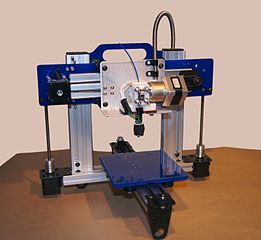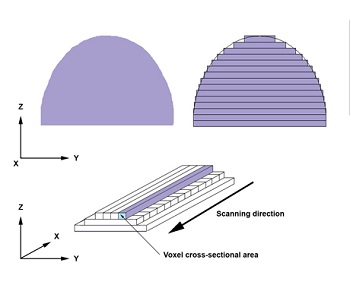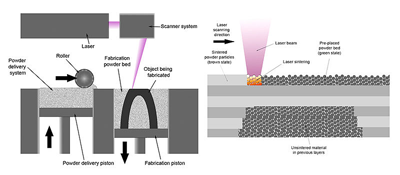Kyle Randolph is a Senior Mechanical Engineering Major at USC. When he isn’t studying he can be found mountain biking and running.
Utilizing precision computer control and harnessing advances in materials science, the development of the three-dimensional (3D) printer has opened up a new realm of manufacturing possibilities. The 3D printer is a device which can create three dimensional objects from plastics and metals. Complex geometries and surfaces are now reproducible. While initially developed for the manufacturing industry, 3D printing has ancillary applications in a variety of other fields. Architecture, biotechnology, forensic pathology, and even food production stand to benefit from this technology.
Introduction
Still largely in its technical infancy, the three dimensional (3D) printer represents the evolution of the digital bridge which began with the desktop printer. Look into any home, dormitory, or business and more likely than not, you will find a digital desktop printer. The ability to span the digital realm and produce tangible documents was created by technology that has been available since the 1960s, using only one medium and two dimensions. The future lies in adding one more dimension to the equation, one dimension which opens up a world of possibilities.
A three 3D printer is a device that reproduces a 3D design using polymers and metals (see Fig. 1). Three dimensional objects are built up slowly by the printer layer by layer. First, the printer prints, or deposits, material in the shape of a “slice” of the 3D model. The “slice” then solidifies, and the next slice is printed on top of it. These slices add together and, after many slices have been deposited, the combined layers take on the shape of the finished 3D model (see Fig. 2).
What exactly is 3D Printing?
Printing in 3 dimensions requires a variety of technologies which, until recent technological advances, have been mostly considered unfeasible. At its heart, 3D printing is CNC (Computer Numerical Control) Milling in reverse. Both are computer controlled, 3-dimensional methods for creating real objects from digital designs. However, whereas milling is a subtractive method (material is removed to produce an object), 3D printing is additive, meaning the object is created layer-by-layer [1]. This additive method has several benefits: virtually no material is wasted, objects can be produced relatively quickly, and several materials can be combined into one object in one process.
Such a versatile device provides promising potential for application in a variety of fields, ranging from manufacturing and prototyping to architecture, tissue engineering and forensic pathology [2, 3]. Three-dimensional printing realizes the potential of digital design while harnessing mechanical principles with the precision control and mathematical power of the modern computer.
Basic Mechanical Principles
At its heart, the 3D printer is technologically straightforward and is comprised of three main components: the bed, three movable gantries, and a printing head [1]. The bed is a stable base onto which the model is printed, and it provides a surface to which the printing medium can adhere as it is deposited layer by layer. The gantries allow for movement along the three axes of printing: the x- and y-axis (the horizontal plane) and the z-axis (responsible for creating the depth of the model). This system of movable gantries is similar to the ones used in a variety of more common objects such as the arcade claw vending machine. Like those found in a claw machine, the gantries of the 3D printer allow for precise positioning in a plane. The z-axis gantry is analogous to the cable that holds the claw, allowing for changes in height or depth.
To achieve precise movements, the gantries are powered and moved by precision motors called stepper motors. Stepper motors are slightly more complicated than electric motors. Rather than being driven by continuous current and voltage, they are driven by digital pulses. Each pulse only moves the motor a small fraction of a full rotation, allowing for high resolution movement. The pulse system also allows the 3D printer to track the position of each gantry at all times by counting the number of pulses that have been sent to the motors and calculating the physical distance they have traveled.
The printing head is the key to the whole operation. It is mounted onto the moving gantries and is responsible for laying down the material that will eventually make up the 3D model. There are a variety of methods of deposition based on the specific needs of the model [1]. Some printers use an extrusion method whereby molten plastic or metal from a reservoir is slowly dispensed through a small nozzle and used to “draw” each layer. This method is analogous to decorating a cake with an icing bag. Another method uses a powerful laser to selectively cure or harden a liquid resin by passing over it. The printer head is the most technically complex component of the device. Many variables including layer thickness and material temperature must be constantly be maintained to ensure the model is an accurate representation of the digital design.
Different Materials, Different Methods
While the basic mechanics of three-dimensional printing are constant, there is no “one-size-fits-all” method to print an object. The choice of printing method depends on the material required for the application. Each of the three main technologies is tailored to work best with certain types of materials.
One of the main technologies used is selective laser sintering (see Fig. 3) [1]. This method uses a powdered polymer or metal and a laser to create each layer of an object. For each layer, the entire bed of the printer is covered in the powder while a powerful laser moves over it in the desired pattern. The powder that is hit by the laser melts together, or is “sintered,” and remains solid. After a layer is completely sintered, the bed of the printer descends and the process is repeated until the object is completed. At the end of the print job, the object is retrieved from the bed of excess loose powder. The un-sintered powder can be used again for a future printing round.
Another common method for printing is stereolithography. Stereolithography is based on the same concepts as selective laser sintering, except that instead of powdered polymer, a liquid, UV-sensitive polymer is used. The liquid polymer is used in conjunction with an ultraviolet laser to selectively harden portions of the liquid polymer layer by layer. Like the sintering process, the excess unused material is simply reused after the print is completed. Due to the specialized materials and the powerful lasers required, these two methods are incredibly expensive.
The more cost-effective alternative to these methods is fused deposition modeling (see Fig. 4) [1]. This method uses thermoplastics (in which plastics which melt at high temperatures and solidify when cooled) in conjunction with a heated extrusion nozzle. The thermoplastics are fed, often in pellet form, into a hopper where they are fed into a nozzle. Heating elements within the nozzle liquefy the material and force or extrude it through a nozzle. This liquefied plastic is then used to deposit a layer of the object. The plastic cools and hardens rapidly as it exits the extrusion nozzle. This process is then repeated for each layer. The thermoplastics are hot enough to melt and fuse to each other, thereby allowing successive layers to combine into one solid object. Fused deposition is currently the method of choice for the burgeoning segment of hobbyist-built 3D printers due to the inherent simplicity and ease of construction [4].
The Myriad of Possibilities for 3D Printing
The ability to recreate digital objects tangibly in three-dimensions opens up a whole new realm of possible applications in a wide array of fields. Manufacturing firms, for instance, are particularly interested in using new printing technology for rapid prototyping. Rapid prototyping allows for models to be produced cheaply and quickly to finalize designs before committing to the large investment of a full-scale production run [5]. These prototypes are the important step between the CAD design and the end product, allowing engineers to verify that each part functions properly and meets the expected design outcomes.
The 3D printer is also used for the actual production and manufacture of an object rather than for drafting prototypes. 3D printers have a manufacturing advantage in that disparate materials can be mixed in the same printing process, not unlike using different colored inks in a desktop printer. Metal and plastic components of an object can be printed during a single printing process [6]. This allows for mechanical components such as metal ball bearings to be printed directly inside a plastic component, freeing the designer from needing to design around existing mechanical fixtures. In some cases, this ability to mix and match materials allows for parts that would impossible to create using conventional machining methods to be fabricated.
In addition, the 3D printer also has applications outside of the engineering and manufacturing realm. One interesting application is the use of 3D printing as a tool for archaeologists to better understand details of our past [2, 3]. Archaeologists could scan one-of-a-kind artifacts and print them for in-depth study. This allows archaeologists all around the world to study the same artifact without shipping the original around the globe. This process also allows for reproduction of broken artifacts by digitally joining various uncovered pieces and printing what the artifact looked like originally. There are also potential applications in forensics and crime scene investigations. Investigators could use 3D printed models to visualize and contextualize evidence in a case, perhaps even providing a breakthrough discovery.
The 3D printer also has applications to our personal health and well-being. The biotechnology industry, in particular, is interested in its potential for improving personalized treatments. For example, cosmetic dentistry uses 3D printers to create custom-fitted braces made out of clear plastic, an application that many have probably experienced without realizing the complexity of the technology that made it possible. Other applications include the ability to print replacement joints and bones. One of the most exciting prospects is the printing of replacement organs. In the near future, doctors may be able to customize replacement organs for patients waiting for a transplant.
Finally, three-dimensional printing has the ability to change aspects of everyday life. In the future, stores may not carry inventory or stock, but instead print out products on-demand. This would ensure that product is never wasted while decreasing the store’s carbon footprint. In addition, the concepts and technology of 3D printing could be applied on a larger scale, and by replacing the conventional printing mediums of plastic with concrete and metals, even produce large objects such as houses and buildings [7]. Through this elimination of manual labor, quality inexpensive housing could be a reality.
A more whimsical application that is currently being developed is food fabrication [8]. Applying printing technology to food is still in its infancy, with most food printing occuring only in university engineering labs. However, more experimental and enterprising chefs are looking to test the limits of the technology, using printers to create textures and tastes that challenge the conventional knowledge of food. Food printing allows for small-scale customization of goods. Generally, in the large scale of industrial food production, such customization via conventional methods would be financially impractical. Food chemists are also seeking to use 3D printers to tailor food to individual nutritional needs. For example, a chef could print a dessert that is visually identical to another dessert, while containing a sugar substitute or reduced sugar content for the diabetics at the dinner party.
Conclusion: Unforeseen Implications
Like any other developing technology, further research and development are transforming 3D printing from what was once a cost-prohibitive method to a more cost-effective, efficient, and readily available tool. This evolution has the potential to fundamentally alter society in ways yet unimagined. Just as the advent of digital music challenged the notion of intellectual property rights, 3D printing will raise some lifestyle changes and ethical challenges. The first copyright infringement case has already been brought before the courts [9]. The issue deals with businesses which allow users to upload digital designs which then are printed out by the company for a fee. Currently, there is no precedent for determining whether or not uploaded designs are copyrighted or can legally be printed; as such, the consumer 3D printing market is operating an undefined legal gray area [10, 11]. As the technology becomes more ubiquitous, these legal impediments will all but disappear allowing the full potential of the 3D printer to make its debut. The future of 3D printing is an exciting one, providing a myriad of useful applications and possibilities we have yet to dream of.
References
-
- [1] Steve Upcraft, and Richard Fletcher. “The rapid prototyping technologies. ” Assembly Automation 23.4 (2003): 318-330. ABI/INFORM Global, ProQuest. Web. 8 Mar. 2011.
- [2] 3D Printing: The Printed World | The Economist.” The Economist – World News, Politics, Economics, Business & Finance. 10 Feb. 2011. Web. 08 Mar. 2011.
- [3] “Printing Body Parts: Making a Bit of Me | The Economist.” The Economist – World News, Politics, Economics, Business & Finance. 18 Feb. 2010. Web. 01 Apr. 2011.
- [4] Raby, Mark. “Desktop Factory Begins Taking Orders for 3D Printer | TG Daily.” TG Daily | Technology, Science, Entertainment, and Business News. 13 Sept. 2007. Web. 11 Mar. 2011.
- [5] Marina I Hatsopoulos. “3D printing speeds design cycle. ” Design News 21 Aug. 2000: Sciences Module, ProQuest. Web. 8 Mar. 2011.
- [6] Ribeiro, Fernando. “3D Printing With Metals.” Computing & Control Engineering Journal 9.1 (1998): 31-38. Print.
- [7] Smith, Dan. “Your Next House Could Come Out of a Printer | Popular Science.” Popular Science | New Technology, Science News, The Future Now. 24 June 2009. Web. 01 Apr. 2011.
- [8] Segall, Laurie. “This 3D Printer Makes Edible Food – Jan. 24, 2011.” Business, Financial, Personal Finance News – CNNMoney.com. 24 Jan. 2011. Web. 08 Mar. 2011.
- [9] Doctorow, Cory. “3D Printing’s First Copyright Complaint Goes Away, but Things Are Just Getting Started.” Boing Boing. 21 Feb. 2011. Web. 08 Mar. 2011.
- [10] “Klein Bottle by Bathsheba on Shapeways.” Shapeways | Passionate about Creating. 2009. Web. 11 Mar. 2011. <http://www.shapeways.com/model/25918/klein_bottle.html?gid=sg4660>.
- [11] “Shapeways | Blog: IP, 3D Printing & DMCA.” Shapeways | Passionate about Creating. 20 Feb. 2011. Web. 08 Mar. 2011.
- [12] Lipton, Jeffrey. “Printing Food.” Cornell Creative Machines Lab. Cornell University, 2007. Web. 21 Apr. 2011. <http://creativemachines.cornell.edu/node/194>.







